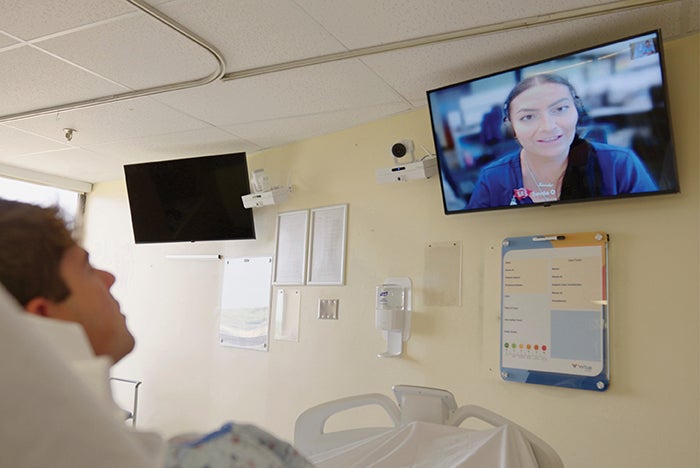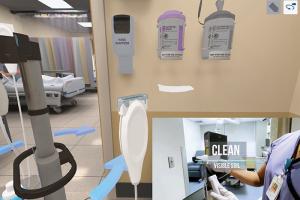Smart care spreads across Virtua Health

Virtua Health invested in its network infrastructure to enable major technology upgrades.
Image courtesy of care.ai
South New Jersey’s Virtua Health is nearing its goal of transforming nearly every inpatient room across its five hospitals into smart rooms with virtual care capabilities. Through the installation of the care.ai platform — a combination of advanced sensors and television displays operating on the AI Smart Care Facility Platform — Virtua Health is connecting patients to more than 400 physicians, nurses and care coordinators.
“We have more than 800 devices in circulation today, representing a mix of wall-mounted and mobile carts,” says Erica Carney, director of virtual care transformation, Virtua Health. “By end of year, we will have north of 1,200 devices across the enterprise supporting patients virtually.” The system expects to have all devices deployed in under two years.
The project grew out of lessons learned from the system’s Hospital at Home program, launched in 2022.
“That opened up our eyes to what can be done virtually and how that model could be applicable to our brick-and-mortar facilities,” says Michael Capriotti, president of advanced care operations and logistics and senior vice president at Virtua Health. “It’s allowed us to support and supplement areas where we may have increased volumes and clinician shortages.
The smart rooms use technology from care.ai., based in Orlando, Fla., including R2-Pro sensors, which integrate a camera with standard pan-tilt-zoom features and an ambient sensor. With its 30x optical zoom lens, the camera allows staff in Virtua’s Care Logistics Center in Pennsauken, N.J., to see patients’ pupils and IV lines with clarity. The ambient sensor overlays light detection and ranging mapping with thermal imaging to help hospital staff monitor movement in patient rooms. In dual-occupancy rooms, multiple cameras are present to focus on each bed.
Having prioritized installation within acute care spaces, Virtua Health first launched a systemwide intensive care unit telehealth program. Virtual hospitalists observe patients during the overnight shift, and remote specialists can be brought in to consult. The smart system also is supporting virtual conferencing with physicians, nurses, care coordinators and patients. Virtua staff can initiate video conferencing by virtually “knocking,” which requires a patient to initiate the audio-video feed. Family members can be invited to participate remotely.
The project required updated cabling and new televisions across the enterprise. The system has switched to smart TVs to support interaction through the care.ai devices. Prior to making upgrades, Carney advises other systems to identify each facility’s infrastructure constraints and use that information to guide installation sequencing




